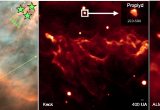Keck and JWST to study how massive stars’s radiation influence their environments
The most detailed and complete images ever taken of a Photo-Dissociation Region (PDR) in the closest site of massive star formation, the Orion Molecular Cloud, have been obtained with the Keck telescope and portends what JWST should soon accomplish. These observations are critical for understanding the interaction of young massive stars with the gas and dust cloud in which they are born and where Sun-like stars form.
Massive young stars emit large quantities of ultraviolet (UV) radiation that affect the physics and chemistry of their local environment; how this surge of energy the stars inject into their native cloud impacts and shapes formation of stars, like the Sun, is not yet well known.
We observed with Keck-II NIRC2 and its adaptive optics system the iconic Orion Bar. This irradiated neutral zone heated by starlight is a prototype of a Photon-Dominated Region (PDR) representative for many star-forming regions in galaxies throughout the universe. The Orion Nebula is the closest massive star formation region to us and may be similar to the environment in which our solar system was born.
The new Keck observations allow us to peer into the nebula down to scales of a 40 AU (10 AU is the distance from Saturn to the Sun).
We were able to spatially resolve and distinguish the Orion Bar’s different substructures - such as ridges, filaments, globules and proplyds (externally illuminated photoevaporating disks around young stars) - that formed as massive stars sculpted the nebula’s mixture of gas and dust. We see in detail where gas in its PDR changes from hot ionized gas, to warm atomic, to cold molecular gas. Mapping this conversion is important because the dense, cold molecular gas is the fuel needed for star formation.
Never before have we been able to observe at a such small spatial scale how interstellar matter structures and how planetary systems could form in environments strongly irradiated by massive stars. This may allow us to better understand the heritage of the interstellar medium in planetary systems.
This portends what JWST should accomplish and how it complement the highest-resolution ALMA maps. These pathfinder observations have assisted in the planning of the JWST Early Release Science (ERS) program PDRs4All: Radiative feedback of massive stars. Very soon, we will use 3 of the 4 instruments aboard JWST, more specifically NIRCam, NIRSpec, and MIRI. JWST will give access to multiple spectroscopic images with a similar spatial resolution but will increase the signal-to noise, contrast and provide a unique insight into the local physical conditions (temperature, density and pressure) and chemical composition of these regions.
Contact at IAS : Emilie Habart
Keck press release : https://keckobservatory.org/orion-pdr
Publication in the journal Astronomy & Astrophysics : https://arxiv.org/pdf/2206.08245.pdf





